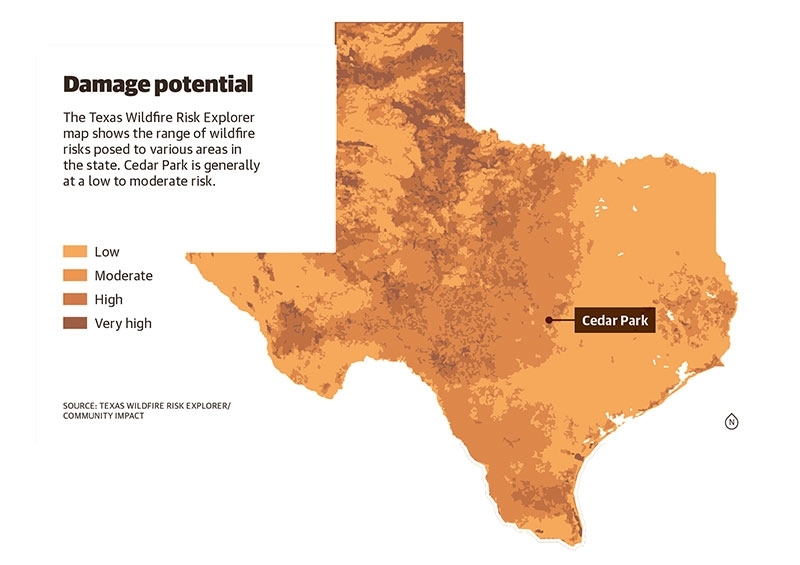The 50-acre 2023 Parmer Lane fire in Cedar Park destroyed a 24-unit apartment building and three other structures, according to previous reporting. People nearby were evacuated, and water had to be conserved so firefighters had ammunition to fight the fire.
Ultimately, emergency responders were able to successfully employ new methods to handle the fire, but for people looking to get ahead of future blazes, the time is now.
Current Situation
Increased heat, extended drought conditions and other factors have led to a heightened risk of wildfires across the western United States, according to the National Oceanic and Atmospheric Association.
People can take a number of precautions to prepare their property and home, and• Community Impact• talked to local officials to find out how to best prepare.
Winter and summer are the highest risk seasons for wildfires in Texas, according to the Western Fire Chiefs Association. The winter risk is due to cold fronts bringing dry air into the state, and the summer risk is due to high heat and extended drought conditions.
Cedar Park Fire Chief James Mallinger said the city is what is considered to be a wildland urban interface, meaning much of the city is densely populated, but there are areas in town that push up against wild spaces and could be at risk of wildfire damage.
In August 2023, Cedar Park’s position as a WUI made it vulnerable to a 50-acre brush fire that destroyed multiple buildings.
“Unfortunately for us, Cedar Park was the first test of the new regional mutual aid autoaid system,” Mallinger said about the blaze. “Fortunately for us, it worked well.”
He noted that over 50 fire trucks from various localities came in to fight the fire.
Mallinger said Cedar Park is typically at a moderate fire risk, but that risk increases in dry and windy conditions.
The specifics
There are many things to consider in preparing a home to resist damage during a fire. One of the main things people can do to protect their home from a wildfire is to create a fire break.
“You want to have what we consider a defensible space around your home. In that defensible space, you want at least 5 or 10 feet around your home where nothing’s going to burn,” Mallinger said.
Lt. Matthew Selby with Emergency Services District 4 said homeowners can use xeriscaping, landscaping that reduces or eliminates the need for watering, and noncombustible features to create fire breaks. It’s also important to clean out gutters and make sure trees and plants are trimmed and not touching the house, he said.
Mallinger said it’s crucial for people to make sure any grass or shrubs they have are well watered so they are slower to burn, and to adhere to watering restrictions when they are in place.
Additionally, homeowners need to get rid of “laddering fuel”—things such as bushes that lead to higher bushes and eventually to trees or the house.
Ember awareness is also important, Mallinger said, noting that roof eaves have ventilation holes.
“That is a lot of times where we see embers fly in and start a fire inside a home or inside a business,” he said.
Plants to use for xeriscaping:
Native plants: adapted to local conditions and can help reduce water and maintenance
Ornamental grasses: drought-tolerant and add texture and movement
Mediterranean plants: lavender and rosemary thrive in dry conditions
Wildflowers: drought tolerant and can add color and beauty to xeriscaped landscapes
Succulents: store water inside them, making them well-suited for xeriscaping
SOURCE: Brazos River Authority
Looking ahead
Though short-term trends can be difficult to predict, the changing climate in the state is exacerbating the danger and risk of fires, according to a study from the Meadows Center for Water and the Environment at Texas State University.
Wind, humidity, surface dryness and vegetation presence are all factors that make it difficult to accurately predict short-term trends.
Dryness is projected to increase and humidity levels to decrease by 2036, so high-risk periods for statewide wildfire risk are expected to increase considerably, especially in eastern Texas, according to the university.
Locally, according to The Meadows Center for Water and the Environment, vegetation presence and surface dryness play a large role in contributing to the risk environment.
The gist
Mallinger said the fire department does annual training to be ready to fight wildfires. The training includes shelter practice, where firefighters rehearse deploying emergency shelters in case they get caught in a wildfire.
The department also does brush truck apparatus training to ensure they are familiar with their equipment when they need it.
“The fire department’s prepared to respond if needed,” Mallinger said.
Another part of Cedar Park preparations is being available to homeowners and occupants when they call with questions about how to prepare.
The parks department and fire department will go out when a call is received, and staff from the departments will help people assess their fire risk situation. Ultimately, the departments will provide recommendations on how people can safeguard their property.
Daniel Sousa, Cedar Park's community affairs assistant director, said the city prefers residents communicate fire concerns with the city through its Report It! system.

The bottom line
An important part of being ready for a fire is preparing a go bag. Selby said people should consider the things they use on a daily basis, such as medicines, when preparing a go bag.
“A lot of people are on medications that if they don’t take daily, they have medical complications,” he said.
Mallinger said local resources are crucial and noted that water conservation efforts help the fire department be prepared to fight fires.
“Remembering to conserve water so it’s there for emergencies is one of the biggest things residents can do to help us be prepared for a wildfire,” he said.
Drinking water and water for fighting fires comes from the same source, he said. The city estimated that during the three days it took to fully extinguish the 2023 fire, the fire department used 8 million gallons of water, he said.
As of April 1, Cedar Park was under Stage 3 water conservation requirements, meaning residents were limited to one day per week for outdoor watering, according to the city’s website. Additionally, the city was subject to Williamson County’s burn ban that was instituted March 25 for up to 90 days, according to the website.
Residents of Cedar Park always have to obtain a permit before doing any outdoor burning. Locals are encouraged to sign up for emergency alerts at www.warncentraltexas.com.
What to take with you in an emergency:
- Important documents (birth certificates, social security cards)
- Wallet
- Cash
- Medicine
- Important photos, family pictures
- Bottle water
SOURCES: Texas Comptroller, www.texasproud.com





